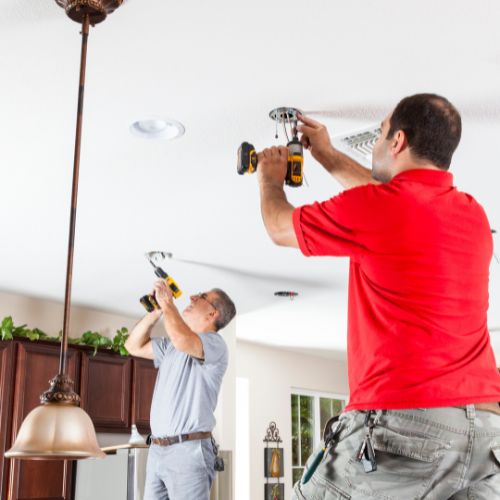
Lighting plays a vital role in enhancing the ambiance and functionality of our homes. However, it’s essential to prioritize safety when it comes to lighting installations and usage. By implementing proper lighting safety measures, homeowners can protect themselves and their families from potential hazards. In this blog, we will discuss essential lighting safety tips that every homeowner should be aware of to create a safe and well-lit environment within their living spaces.
Choose Quality Lighting Fixtures
Investing in high-quality lighting fixtures is crucial for ensuring safety and longevity. Opt for reputable brands and products that adhere to safety standards. Cheap or poorly made fixtures can pose risks such as electrical malfunctions, overheating, or even fire hazards. Look for the appropriate certification marks, such as UL (Underwriters Laboratories), to ensure the fixtures meet the necessary safety requirements.
Select Appropriate Light Bulbs
Using the correct light bulbs is essential for preventing electrical issues and minimizing the risk of accidents. Check the recommended wattage for each lighting fixture and use bulbs that match the fixture’s specifications. Exceeding the recommended wattage can cause overheating, leading to potential fires or damage to the fixture. Consider using energy-efficient LED bulbs, which consume less electricity and have a longer lifespan compared to traditional incandescent bulbs.
Regularly Inspect and Maintain Lighting Fixtures
Performing routine inspections of your lighting fixtures is crucial to identify any signs of wear, damage, or loose connections. Check for cracked or damaged lenses, loose wiring, or signs of overheating, such as discoloration. Replace any faulty fixtures or components promptly. Additionally, keep fixtures clean and free from dust accumulation to prevent potential fire hazards.
Pay Attention to Outdoor Lighting
Outdoor lighting not only enhances the aesthetics of your home but also plays a significant role in security. Ensure all outdoor lighting fixtures are weatherproof and specifically designed for outdoor use. Regularly inspect and clean outdoor lighting to remove debris, spider webs, or other obstructions that can affect their performance. Additionally, install outdoor lighting with motion sensors to deter potential intruders.
Proper Electrical Wiring
When it comes to lighting installations, it’s crucial to prioritize proper electrical wiring. Avoid DIY electrical work if you are not a trained professional. Hire a licensed electrician for any electrical installations, repairs, or upgrades. Faulty wiring can lead to electrical shocks, short circuits, or fires. It’s also important to avoid overloading circuits by distributing the load evenly and using surge protectors when necessary.
Childproofing Outlets and Switches
If you have young children, it’s crucial to childproof electrical outlets and switches. Install outlet covers or tamper-resistant outlets to prevent children from inserting objects or fingers into them. Use childproof switch covers to prevent accidental toggling of lights, which can cause potential hazards.
Install Ground Fault Circuit Interrupters (GFCIs)
GFCIs are essential safety devices that protect against electrical shocks. Install GFCIs in areas where water is present, such as kitchens, bathrooms, or outdoor lighting. GFCIs detect imbalances in electrical currents and immediately shut off the power to prevent electrical shocks.
Use Extension Cords Wisely
Extension cords should only be used temporarily and sparingly. Avoid running extension cords under carpets or rugs, as they can overheat and cause fires. Ensure that extension cords are rated for the intended usage, and never overload them with high-wattage appliances. Regularly inspect extension cords for frayed or damaged wires and replace them if necessary. Whenever possible, it is best to install additional outlets to avoid relying heavily on extension cords.
Be Mindful of Overloading Circuits
Overloading circuits can lead to electrical malfunctions and fire hazards. Distribute the electrical load evenly across different circuits in your home. Avoid plugging multiple high-wattage appliances into the same circuit simultaneously. If you frequently experience circuit breakers tripping, it may be a sign of overloaded circuits and you should consult an electrician to assess and address the issue.
Practice Fire Prevention
Fire prevention should be a top priority when it comes to lighting safety. Keep flammable materials away from light fixtures, lamps, and bulbs. Ensure that lampshades and other coverings are heat-resistant and do not come into direct contact with light bulbs. Install smoke detectors throughout your home, and regularly check and replace their batteries.
Dimmer Switch Safety
Dimmer switches are a convenient feature that allows you to adjust the brightness of your lights. However, it’s important to choose dimmer switches compatible with the type of lighting fixtures and bulbs you are using. Improperly matched dimmer switches can cause flickering lights or even damage the bulbs and fixtures.
Emergency Lighting Preparedness
Prepare for unexpected power outages or emergencies by having emergency lighting solutions in place. Keep flashlights or battery-powered lanterns easily accessible in case of emergencies. Consider installing backup power systems, such as generators or uninterruptible power supply (UPS) units, to provide temporary power during outages.
Educate Yourself on Electrical Safety
Stay informed about electrical safety practices and guidelines. Educate yourself about the basics of electrical systems, such as identifying the location of your electrical panel and understanding how to safely reset tripped breakers. Familiarize yourself with the proper use and maintenance of electrical appliances, extension cords, and power strips.
Consider Energy Efficiency
In addition to safety considerations, energy efficiency can help reduce electricity consumption and lower utility bills. Opt for energy-efficient lighting options, such as LED bulbs, which consume less energy and have a longer lifespan. Consider installing motion sensors or timers to automatically control lighting and minimize unnecessary energy usage.
Conclusion
Prioritizing lighting safety in your home is crucial for creating a secure and comfortable living environment. By following these essential lighting safety tips, homeowners can minimize the risk of electrical hazards, fires, and accidents. Remember to invest in quality lighting fixtures, choose appropriate light bulbs, conduct regular inspections and maintenance, and be mindful of proper electrical wiring and usage. By illuminating your home with safety in mind, you can enjoy a well-lit space while protecting yourself, your loved ones, and your property.


